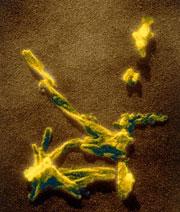 Prions may need help to make it through the gut wall.© EYE OF SCIENCE / SCIENCE PHOTO LIBRARY
Prions may need help to make it through the gut wall.© EYE OF SCIENCE / SCIENCE PHOTO LIBRARYThe infectious proteins called prions that cause the human form of mad cow disease may hitch into the body on the back of another meat protein, US researchers have shown. The finding may help to explain how the rogue prions jump between species.
Disease-causing prions are thought to have passed into people when they ate beef from infected cattle, triggering the brain wasting condition called new-variant Creutzfeldt-Jakob disease, or vCJD. But researchers have not been sure exactly how prions enter the body.
To find out, Neena Singh and her team at Case Western Reserve University in Cleveland, Ohio, mimicked the process of eating and digesting infected meat.
They mashed up brain tissue that contained prions from patients who had a form of Creutzfeldt-Jakob disease. They then exposed it to a range of harsh digestive enzymes from the mouth, stomach and intestine, which normally break proteins into pieces.
Prions, which are known to be enormously tough, escape this attack almost unscathed, they showed, as does a second type of protein called ferritin, which stores iron and is abundant in meat. The two proteins seem to stick together, they report in the Journal of Neuroscience1.
The researchers next added the digested slurry to a lab model of the human gut: a growing sheet of cells from the intestinal lining. By attaching fluorescent tags to the two proteins, they showed that they are transported through the cells hand-in-hand. "Prions probably ride piggyback" through the gut wall into the body, Singh says.
Leaping hurdles
Singh proposes that a large amount of, but not necessarily all, prions in infected meat enter the human body this way. A study from 2001 suggests that prions can also pass through the gut unaided, through a specific subset of intestinal cells2.
Singh's study may explain how prions jumped the species barrier in the first place. The ferritin protein is almost identical in a wide range of species, which might allow it to latch on to and ferry foreign prions from cows.
Singh proposes that ferritin might transport prions to humans from other animals with prion disease, such as deer and elk suffering from chronic wasting disease. There are suspicions that some people who have eaten wild meat have picked up a form of the condition.
Hobbling the transport of ferritin might block prions from entering the body. But this would be difficult to use therapeutically, Singh says, because people would have to be treated at the time when they were being exposed, which is many years before symptoms of the disease emerge.
